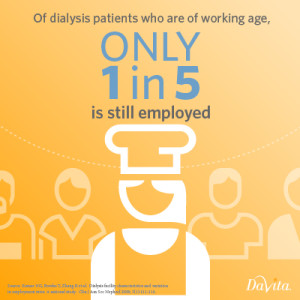January 17, 2014
Kidney Care Trends That Will Shape 2014
It’s the beginning of a new year, and that means medical professionals are setting goals to further improve health outcomes for their patients. This is particularly important for patients who suffer from complex, chronic illnesses.
I’ve compiled a list of trends that I predict will play a large part in shaping kidney care during 2014, with a focus on patients with end stage renal disease (ESRD).
 Working patients. This was a hot topic closing out 2013 and will continue to gain attention throughout 2014. Admittedly, for some patients there are medical reasons that prevent them from  working when on dialysis; however, I foresee the kidney care community turning its focus toward the education of patients, employers and the public about the benefits of continuing to work despite being on dialysis. A key part of this educational effort will be an emphasis on treatment options for patients who can continue working. For such patients, the use of home dialysis modalities is particularly helpful.
Working patients. This was a hot topic closing out 2013 and will continue to gain attention throughout 2014. Admittedly, for some patients there are medical reasons that prevent them from  working when on dialysis; however, I foresee the kidney care community turning its focus toward the education of patients, employers and the public about the benefits of continuing to work despite being on dialysis. A key part of this educational effort will be an emphasis on treatment options for patients who can continue working. For such patients, the use of home dialysis modalities is particularly helpful.
Healthy living. From exercise to diet, healthy living for dialysis patients will take center stage this year. Many dialysis patients believe they cannot safely exercise or that they do not have the stamina to exercise. In fact, dialysis patients are not only capable of exercising, but there are physical and psychological benefits to doing so. Of course, I recommend consulting your physician before starting a workout regimen. And what would a good exercise regimen be without a diet plan? I agree with Sara Colman, DaVita renal dietitian, that “2014 will bring even more focus to quality of food and nutrition selections.” I’ll be especially interested in seeing how social media plays a role in helping patients participate in the healthy-living movement.
Complex clinical initiatives. Clinical outcomes such as dialysis adequacy, anemia management and catheter reduction are clearly important indicators—and will continue to serve as barometers of consistent and positive clinical improvements. But when it comes to actively helping kidney patients lead a quality life, complex clinical initiatives that aim to keep patients healthy and out of the hospital and improve their overall well-being will take high priority in 2014 and beyond. Programs that address large-scale issues such as fluid, diabetes, infection and medication management will ultimately drive results that help improve patients’ quality of life.
Integrated care. Patient-centric, holistic care is essential to achieving the ultimate goal for kidney patients: improving their health-related quality of life. This means emphasizing management of not only the kidney issues, but the many comorbid conditions that are so common in ESRD patients. These include diabetes, hypertension and cardiovascular disease. Studies clearly show that by providing team-based care that includes physicians, nurses, technicians, social workers, dietitians, nurse practitioners and pharmacists, clinical outcomes can be improved. In addition to the team approach, engagement of patients as full participants in their health is key to success in integrated care.



